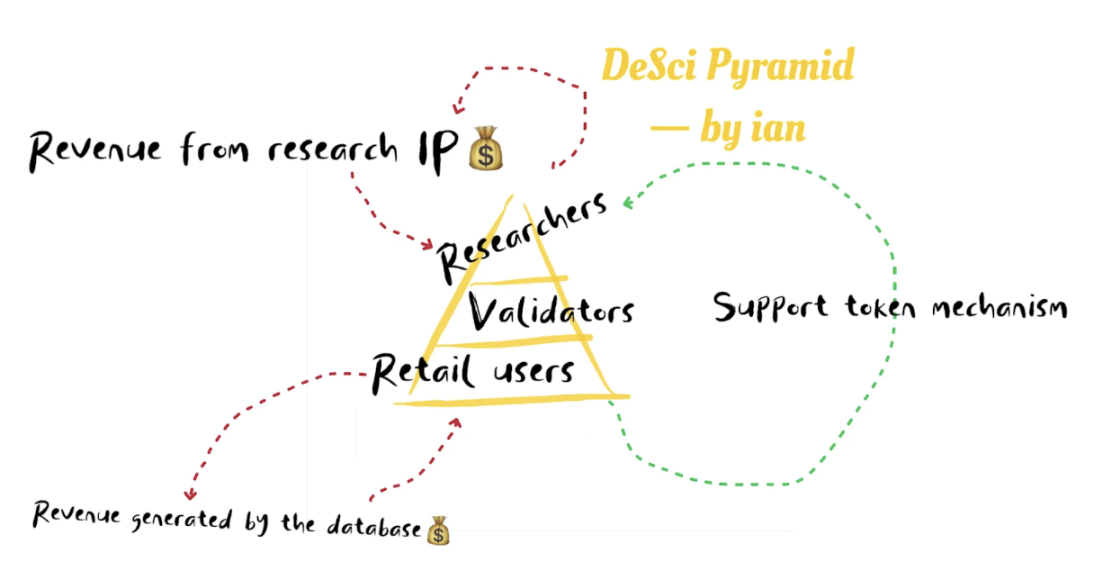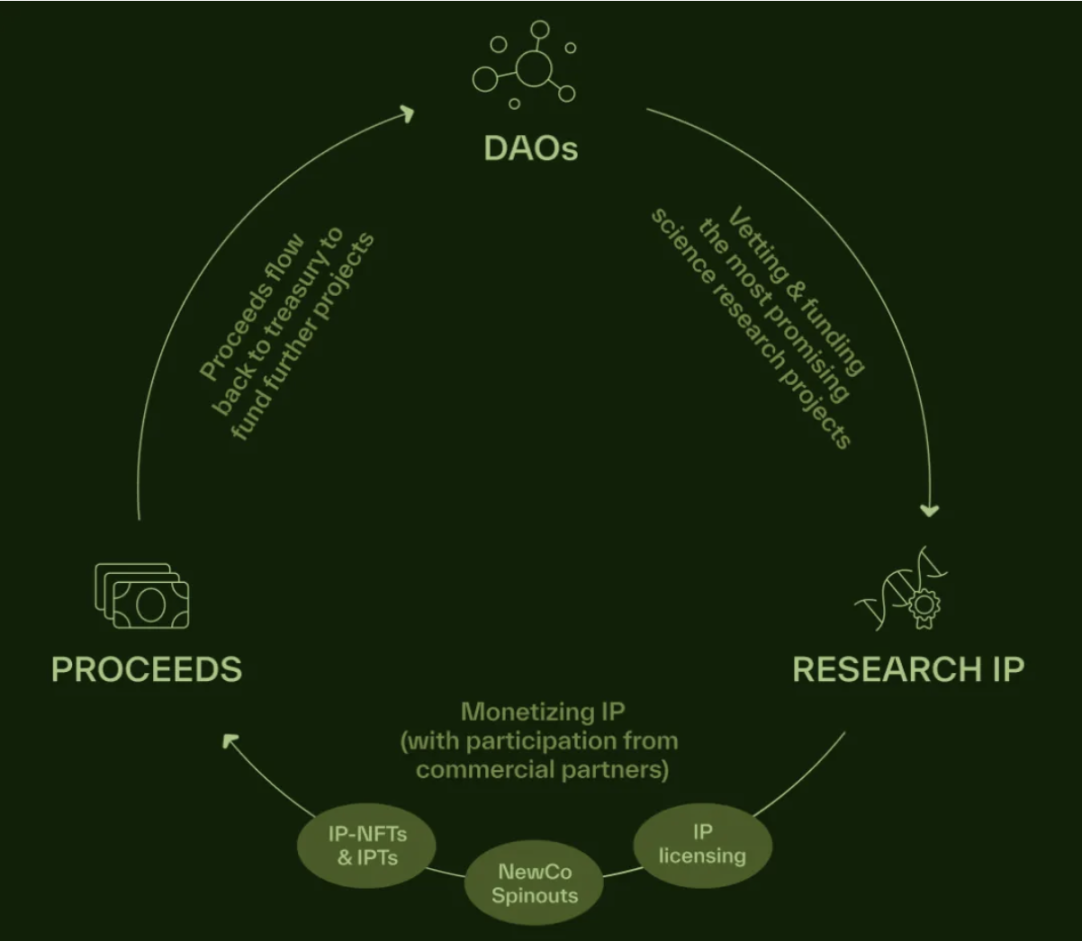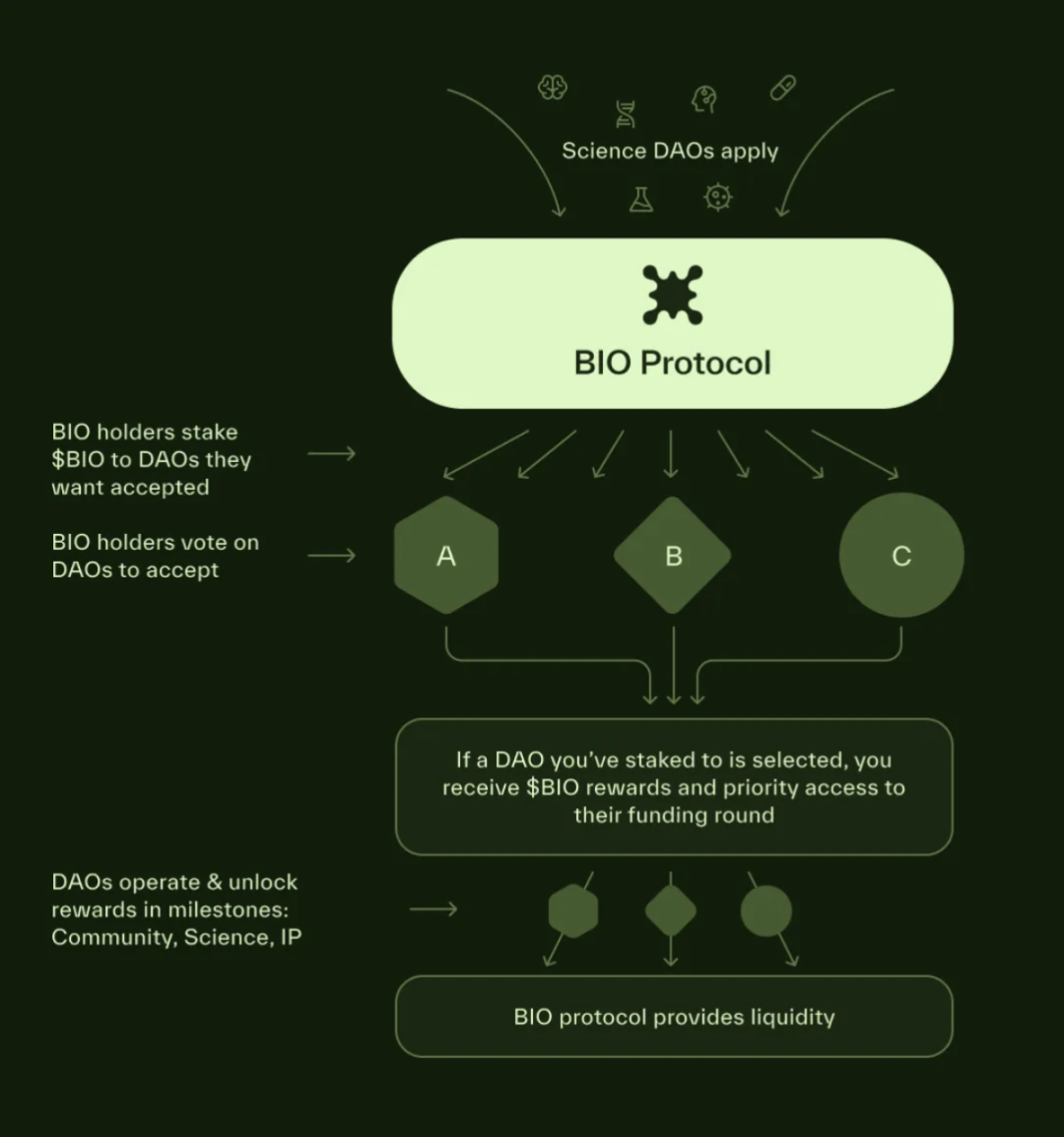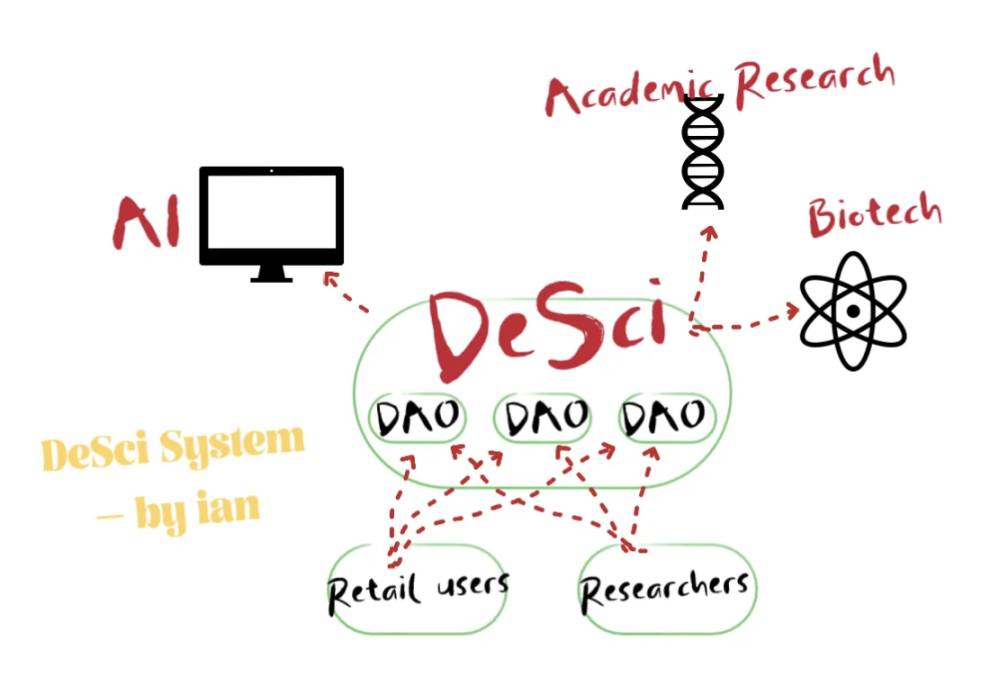By: ian@Foresight Ventures
1. Know DeSci -> Question DeSci -> Understand DeSci
1.1 Understanding DeSci
Pain points:
The lag in infrastructure regarding IP maintenance, access, ownership, and revenue distribution around research or knowledge has always been a pain point, especially in academia.
In the complex field of knowledge sharing and discovery, how to balance security, transparency, reward mechanisms, and accessibility is always an ongoing challenge. Traditional models often rely on centralized verification systems, which may limit inclusiveness and broad participation. In addition, existing systems may not adequately reward or recognize knowledge contributions, which may affect the development of a comprehensive, collective knowledge base.
Issues resolved:
The central idea behind DeSci is that everyone has the opportunity to equally access science and knowledge at any level, and the process of scientific research should be open and transparent to everyone. Therefore, DeSci is committed to creating an ecosystem where knowledge contributors can be incentivized and share their research, and anyone can browse and even iterate on the content permissionlessly.
This creates a completely different scientific research system, in which:
- The allocation of funds is determined by the public through mechanisms such as DAOs, in contrast to traditional science, which is controlled by small, closed, centralized groups.
- DeSci's vision is also to promote dynamic collaboration among various resources on a global scale, which is, to some extent, a breakthrough in the collaboration limitations set by centralized institutions in traditional science.
- The flow of funds is more transparent, and a more efficient economic system is explored with the support of web3, which is completely different from the time-consuming funding decision-making method in traditional science. At the same time, the incentives of tokens and reputation, and the value of peer-review are also emphasized.
- Contributors of knowledge can transparently distribute the intellectual property they generate, unlike in traditional science where intellectual property is owned by the institution and access is opaque. DeSci also encourages sharing of all research data, including unsuccessful attempts, to address the publication bias in traditional science where only successful experiments are shared.
1.2 Questioning DeSci
The original intention of DeSci is to establish an ecosystem for scientists or scholars to share academic research and obtain research IP ownership. For other users, the sense of participation lies more in the easier access to these academic research. In essence, the academic ivory tower has not been broken, and the core players in this ecosystem are still the top scholars.
In what scenario would an ordinary person care about how to access an academic report more easily?
I am afraid that apart from staying up late to finish papers in college, it is difficult to have such a demand after graduation. From a certain perspective, we must admit that the ability to contribute valuable academic IP is only in the hands of a small number of people.
But from the perspective of examining the track and narrative, this is the problem with DeSci. It is too halal and noble, so it is difficult to bring into play the value that web3 can really give it, that is, community effect and efficient economic system. Focusing on one point, the foundation of DeSci is not an open knowledge contribution platform, but an active ecology based on an efficient token system and a strong community effect. The foundation of this economy lies in the extensive participation of users. If users cannot really participate in the gameplay and do not have enough motivation to hold and trade tokens, then the currency price, liquidity and economic system cannot be supported.
Therefore, it obviously does not make sense for the core players to be merely scientists, and it is impossible to form a sustainable mechanism.

2. What kind of DeSci makes more sense?
2.1 Understanding DeSci
Science =/= Knowledge
DeSci should not be the domain of scientists only, but should lower the threshold for ordinary people to access science. So try to avoid using "science" and mention "knowledge" more. Science naturally sets a threshold for DeSci, and knowledge can be data in any form and in any field.
Contributing knowledge in one's own professional field or interest is itself an attractive and easily divisive thing. Therefore, the opening of the "science" pattern makes community participation possible and enables web3 to maximize its value.
I think DeSci should be a pyramid structure, which divides the participants and contributors of the entire knowledge sharing chain into different levels, and each role is indispensable. As participants at the top of the pyramid, scholars contribute the most core value of DeSci itself, and also bring explosive points to the project. Take the scenario of new drug research and development as an example. If DeSci can participate in or promote the launch of a certain drug, the volume it brings to the track and project is immeasurable. Community users, as participants at the bottom of the pyramid, also have the bottom-level gameplay. They maintain the efficient operation of the entire ecological and economic system.

2.2 The cornerstone of DeSci—BIO
2.2.1 Introduction to BIO
BIO Protocol is a decentralized science-finance infrastructure that aims to promote biotechnology innovation through community collaboration. It provides the global community, including patients, scientists, and biotechnology professionals, with tools to fund, develop, and govern scientific intellectual property to accelerate the commercialization of biotechnology research.
Core functions and operating mechanisms: Supporting biotech decentralized organizations - BioDAOs
2.2.2 BIO in-depth
1) Technical details
Bio Protocol’s technology stack and architecture are designed to support the tokenization and on-chain governance of biotech IP.
- By developing a customized public chain, we ensure that bio science technology, development, commercialization, and transaction processes are transparent, verifiable, and secure, while reducing transaction costs.
- The IP-Token mechanism is based on SC. Each IP asset has an independent token and defines its ownership and trading rules. Users can obtain part or all of its ownership through transactions, creating the possibility for circulation and trading in the secondary market while protecting bio science research IP.
- Based on the DAO structure, members manage and fund scientific research projects through BIO token voting. Each DAO can focus on a specific scientific research field, such as VitaDAO focusing on longevity research, CryoDAO focusing on cryonics, etc.
2) Operational model analysis
1. BioDAO

BioDAOs are decentralized autonomous organizations within the BIO Protocol ecosystem. Each BioDAO focuses on a specific scientific field, the most famous of which is vitaDAO. BioDAOs receive ongoing funding, liquidity, and infrastructure support from BIO Protocol to accelerate research progress and increase project success rates.
Among them, the parent platform BIO Protocol provides BioDAOs with:
- Fund: Each BioDAO will receive start-up funds from the BIO Protocol Treasury after being approved. This fund helps BioDAOs obtain initial capital to support early research projects and expand their impact.
- Liquidity support: BIO Protocol is responsible for providing on-chain liquidity for BioDAO. This allows BioDAOs to focus on scientific research without having to worry about market liquidity management issues. Through liquidity support, BIO Protocol helps to improve the liquidity and market value of BioDAOs tokens.
- Governance: BIO Protocol has established a meta-governance layer by holding tokens of multiple BioDAOs. BIO token holders can participate in and make decisions on the operations, funding allocation, and development direction of multiple BioDAOs through meta-governance. This mechanism ensures that BioDAOs within the ecosystem are coordinated in terms of funding flows and research priorities.
- IP Commercialization: BIO Protocol helps BioDAOs transform scientific research results into tradable intellectual property assets through its IP tokenization mechanism. This process allows BioDAOs to tokenize the intellectual property of scientific research projects and trade them on the chain, helping scientific research results obtain early capital support and realize the market value of intellectual property.
- Standardized Framework: BIO Protocol provides a standard framework for the creation and operation of BioDAOs, including token economics design, governance structure, and data management tools. Through standardized frameworks and support, BIO Protocol reduces the difficulty of creating new BioDAOs, enabling them to enter the market faster and operate effectively.
2.Curation

BIO Protocol’s curation mechanism is designed to select and support the most promising BioDAOs to join the BIO ecosystem. Curation is a process driven by the BIO community through which community members can help decide which emerging scientific organizations deserve financial support and ecosystem resources.
Curation Process
- Submit an application: A new BioDAO applies to join the BIO ecosystem. Applicants must have a clear scientific research direction and a preliminary governance structure to ensure that they can effectively advance their research goals.
- Voting for Support: BIO token holders can choose to lock up their BIO tokens and receive voting rights (vBIO). vBIO holders use these voting rights to vote on candidate BioDAOs to decide whether to support them to join the ecosystem.
- Curation Rewards: If a BioDAO application is successful, vBIO holders who voted for the BioDAO can receive the following rewards:
- Voting supporters will have the opportunity to participate in the BioDAO whitelist financing and have priority to invest in the BioDAO's tokens.
- Supporters will receive priority access or discounts on products, data, or services provided by the BioDAO.
- Join the Ecosystem: BioDAOs that successfully pass the curation process will receive initial funding and support from BIO Protocol and be included in the BIO Ecosystem. BIO Protocol will continue to provide them with funding, liquidity, and governance support.
3. Reward Mechanism
Bio/Acc rewards are provided in the form of BIO tokens, including the following scenarios:
- Initial Token Auction via BIO launchpad
- Research funding, i.e. issuance of IP tokens
- IP-related consumer product sales
- The product enters clinical trial stage
At the same time, rewards can also flow directly to users of BioDAO products:
- Participating in clinical trials or self-reporting health data
- Use/purchase products such as Follistatin, Vitarna, electronic implants, etc.
4.ip-token
- BioDAOs develop and hold ownership of IP tokens. Each BioDAO typically holds a portfolio of IP tokens related to its specific area of scientific research. For example, VitaDAO developed and holds equity in the IPTs of VitaRNA and VITA-FAST.
- How IP Tokens work: In addition to potential profit sharing rights, when obtaining IPTs, IPT holders can benefit from the following:
- Governance: Participation in key decisions related to the development, management and licensing of intellectual property.
- Priority Access: Priority or preferential access to innovation, collaboration or future opportunities related to the IP.
2.2.3 Why we invest in BIO
There has been no solution to how to balance security, transparency, and incentives in the field of scientific research. BIO has built the largest DeSci platform to date. While ensuring security and transparency, it has financialized scientific research, which has great financial value. Through countless BIO subnets (eg vitaDAO) that have been screened by the community, the value created by users is commercialized and returned to users through profit sharing. Therefore, $BIO will continue to capture the value created by all DeSci subnets and is the most valuable token in the DeSci field. In the long run, people's demand for health and longevity will continue to increase. BIO will greatly reduce the threshold for participation and use in related fields, and is a project worth betting on in the long run.
The product has gone through a long period of accumulation and iteration. Star projects such as vitaDAO have appeared in the ecosystem, which can prove that the product's operating model is feasible and that there is demand for the product from capital and academia. At the same time, the founding team has strong experience in scientific research and web3. James is the founder of orangeDAO and also participated in YC19W as a founder; Paul is the founder of vitaDAO and molecule. The team has the top influence in the field of DeSci.
3. More than DeSci
The imagination space that DeSci brings to the industry is by no means limited to conduct research or drug discovery. As discussed before, if the scope of DeSci is limited to science, the value and scalability of this track will be greatly limited. If the concept of knowledge co-construction is added, and it is noted that the knowledge here can be data of any field, any dimension, and any size, then the process of building DeSci is more like constructing a huge dynamic database.

How to do DeSci + AI?
Furthermore, DeSci should fragment knowledge. Rather than saying that DeSci has built a decentralized research platform, it is better to say that DeSci is creating a system where everyone has the opportunity to participate in knowledge co-construction. This approach is also naturally complementary to the community attributes of web3. The DeSci ecosystem will promote the organization of data in different fields, such as Gym DAO, which brings together a group of people who are interested in fitness or have mastered some related knowledge, Longivity DAO, which brings together a group of people interested in biomedicine, and even bounty task DAO. For example, a navigation model requires traffic flow and terrain data on different streets in a region. This is not a very systematic data, but it is indeed something that retail investors can collect. These participating users may be experts or enthusiasts in this field. With the blessing of DeSci, the knowledge contributed by anyone has the opportunity to be continuously enriched by other contributors, and DeSci also allows each participant to generate value from the data contributed and obtain continuous profit sharing.
The biggest charm here is that the knowledge and data of any one person must be limited, but it is undeniable that these data have value to a greater or lesser extent, and any research conduct needs to start with the accumulation of the most basic knowledge. If the fragmented data is collected to form a large-scale data set through community co-construction, a chemical reaction of 1 + 1 > 2 will occur.
If we really want to build this web3-based knowledge base, the most important task is to build a community and increase the user base to generate fission. Even onboarding researchers in the cold start phase is secondary. This is different from the way most DeSci play, but I think this method is more crypto native. The motivation for retail investors to participate and hold tokens is to join data organizations through staking to contribute data and obtain incentives or staking income. The more valuable the contributed data is, the more times the data will be cited or associated. Then more valuable data will enable the corresponding array organization to obtain more external income and native incentives. Therefore, such a mechanism not only encourages user participation but also promotes data quality.
However, in such a huge system, there will definitely be users who contribute little or are just filling in the gaps. However, the generation of these junk data does not affect the operation of the system. These users will also be allowed to provide data and participate in staking to try their luck and earn the lowest level of community incentives.












